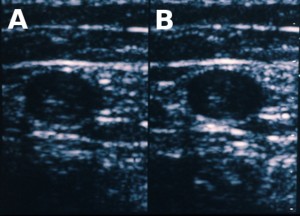The deep veins in the calf include the posterior tibial, anterior tibial, peroneal, muscular and gastrocnemius veins. If they thrombose this is termed a calf vein thrombosis (cDVT) which can be detected by duplex ultrasound as non-compressibility with the absence of flow during a provocation manoeuvre. However, the tibial and peroneal veins are often paired so thrombosis of only one of these may be missed on duplex, because patency of the neighboring vein may give a false sense of security to the unwary. Thrombosis may occur spontaneously (unprovoked) or after an event (provoked) like prolonged immobilization, surgery or foam sclerotherapy. The importance of cDVT is that it can lead to pulmonary embolism (PE).
ATHANASIOS GIANNOUKAS Isolated cDVT represents approximately 50% of all cases of leg DVT. There is controversy as to whether these patients require (i) aggressive anticoagulation for 3 months in addition to a graduated elastic compression stocking, (ii) prophylactic anticoagulation for the prevention of extension or contralateral DVT or (iii) observation alone. The OPTIMEV study from France recognised that isolated cDVT was associated with transient states like recent surgery, travel or immobilisation in contrast to proximal DVT which was associated with chronic states like malignancy, heart/respiratory failure or age >75 years. The mortality of cDVT is half that of proximal DVT (pDVT) and nearly all cDVT patients receive therapeutic coagulation. Interestingly, after stopping anticoagulation cDVT patients have a much lower risk of recurrence than pDVT but both have a similar risk of pulmonary embolism (PE).
The therapeutic aims are to prevent PE, thrombus extension, recurrent thrombosis and the post thrombotic syndrome. An initial no-anticoagulation strategy could be decided if the following conditions are met: (i) absence of severe symptoms, (ii) without a history of malignancy, (iii) no thrombophilia defect, (iv) no previous DVT, (v) if the event is provoked, (vi) only one calf or tibial vein is involved, (vii) the patient is young, able to mobilize and attend a serial ultrasound follow-up. In all other cases it is advisable to add anticoagulation in therapeutic doses for 3 months.
Acute thrombosis of the medial gastrocnemial vein on duplex investigation without compression (A) and during compression (B). The vein is dilated, incompessible containing some echogenic elements.
